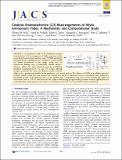Catalytic enantioselective [2,3]-rearrangements of allylic ammonium ylides : a mechanistic and computational study
Abstract
A mechanistic study of the isothiourea-catalyzed enantioselective [2,3]-rearrangement of allylic ammonium ylides is described. Reaction kinetic analyses using 19F NMR and density functional theory computations have elucidated a reaction profile and allowed identification of the catalyst resting state and turnover-rate limiting step. A catalytically-relevant catalyst-substrate adduct has been observed, and its constitution elucidated unambiguously by 13C and 15N isotopic labeling. Isotopic entrainment has shown the observed catalyst-substrate adduct to be a genuine intermediate on the productive cycle towards catalysis. The influence of HOBt as an additive upon the reaction, catalyst resting state, and turnover-rate limiting step has been examined. Crossover experiments have probed the reversibility of each of the proposed steps of the catalytic cycle. Computations were also used to elucidate the origins of stereocontrol, with a 1,5-S•••O interaction and the catalyst stereodirecting group providing transition structure rigidification and enantioselectivity, while preference for cation-π interactions over C-H•••π is responsible for diastereoselectivity.
Citation
West , T H , Walden , D M , Taylor , J E , Brueckner , A C , Johnston , R C , Cheong , P H-Y , Lloyd-Jones , G C & Smith , A D 2017 , ' Catalytic enantioselective [2,3]-rearrangements of allylic ammonium ylides : a mechanistic and computational study ' , Journal of the American Chemical Society , vol. 139 , no. 12 , pp. 4366-4375 . https://doi.org/10.1021/jacs.6b11851
Publication
Journal of the American Chemical Society
Status
Peer reviewed
ISSN
0002-7863Type
Journal article
Description
The research leading to these results (T. H. W., J. E. T., G. C. L.-J. and A.D.S) has received funding from the ERC under the European Union's Seventh Framework Programme (FP7/2007-2013) / E.R.C. grant agreements n° 279850 and n° 340163. A.D.S. thanks the Royal Society for a Wolfson Research Merit Award. P.H.-Y.C. is the Bert and Emelyn Christensen Professor and gratefully acknowledges financial support from the Stone Family of OSU. Financial support from the National Science Foundation (NSF) (CHE-1352663) is acknowledged. D.M.W. acknowledges the Bruce Graham and Johnson Fellowships of OSU. A.C.B. acknowledges the Johnson Fellowship of OSU. D.M.W., A.C.B., and R.C.J. and P.H.-Y.C. also acknowledge computing infrastructure in part provided by the NSF Phase2 CCI, Center for Sustainable Materials Chemistry (CHE1102637).Collections
Items in the St Andrews Research Repository are protected by copyright, with all rights reserved, unless otherwise indicated.

